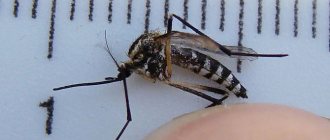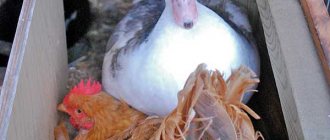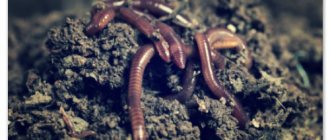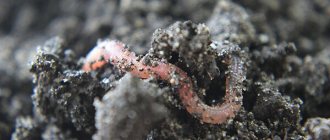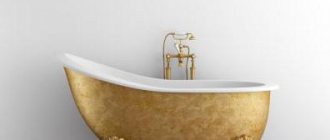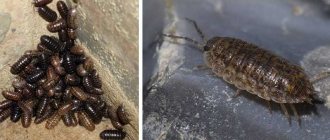Insects in the bathroom: photos and names
One of the reasons for the presence of uninvited guests in bathrooms and toilets is a violation of the proper microclimate, which creates attractive conditions for pests, as well as basic hygiene standards indoors. In such cases, pests actively begin to penetrate from ventilation, cracks, and through balconies.
Most often, centipedes, spiders, silverfish, wood lice, and butterflies (in the photo you can see them enlarged) appear inside the bathroom or toilet, which are easy to get rid of.
White insects in the bathroom
As for the white insects in the bathing room, these could be recently shed silverfish. They are small in size (up to 10 mm), the body is slightly elongated, and has a light gray or almost transparent color. The body ends with three hairs. They run very fast.
Woodlice also acquire a white shell color during molting; during other periods of life they are gray. They are a type of crustacean. They are harmless and do not bite. Occasionally they are able to appear and spoil vegetable and fruit stocks inside pantries.
There are insects in the bathroom and toilet, tadpoles are running fast
If quickly crawling white tadpoles appear, these are common silverfish. It belongs to the small wingless species of the bristletail order. This is one of the most ancient creatures; scientists have proven that this species existed more than three hundred million years ago.
The tadpole got its name due to the presence of small silvery scales. People sometimes confuse silverfish with the centipede flycatcher, but the main difference between the second insect is the large number of long legs.
Silverfish in an apartment do not pose any threat to people and do not have a negative impact on health, but from an aesthetic point of view it is still better to get rid of them.
Social structure and reproduction
Photo: Common tubifex
Tubifex worms are not able to regenerate lost body parts and do not split into two or more parts to form two or more individuals. They are not asexual; these creatures reproduce sexually. The genital organs are located near the ventral part of the body.
Interesting fact: Tubifex worms are hermaphroditic: each individual produces both a sperm and an egg, and during mating, a pair of individuals fertilize each other's eggs.
Mature tubifex worms have a clitellum, a ring-shaped or saddle-shaped stripe towards the front of the body (earthworms have the same structure). The clitellum surrounds about 2 or 3 body segments, including the segments that produce eggs and sperm, and secretes a mucous cocoon that protects the fertilized eggs until they hatch. Tubifex worms do not have a separate larval stage; the young are simply small and immature. As they grow, their length increases by forming new segments just before the very last section.
After copulation, which involves the transfer of sperm between two individuals, the sperm is stored in sacs located behind the female reproductive opening. These fertilized eggs are then arranged like a cocoon. The eggs in the cocoon develop within a few days of being laid, and the worm's development is complete and it becomes a fully functioning worm.
White insects in the bathroom: how to get rid of them?
To combat white insects inside the bathroom and toilet, you must first decide what specific type of parasite is bothering you. And even then, in order to get rid of it, special means are selected.
Before treating the apartment, it is important to restore order inside the room, wash all plumbing equipment, furniture, floors, and walls. It is also necessary to create balanced microclimatic conditions and, if necessary, install additional ventilation and a battery. Eliminate cracks and gaps between ventilation grilles.
Remedies for small white insects in the apartment
When small white bugs run around in the toilet, it causes extremely unpleasant sensations, especially at night. Many people don’t know what to do about it and start to panic instead of quickly getting rid of it.
There are various ways to combat them, but the most important thing is to follow the recommendations to prevent excessive moisture formation.
The most effective insecticidal preparations aimed at getting rid of intrusive guests that you unexpectedly have include the following:
To get rid of insects, you can also use various chlorine-based substances; they are useful for treating corners and places where mold forms. Using copper sulfate, dry the washed walls, directing the warm air flow with a fan.
In an apartment, it is advisable to use a mixture of boric acid and chalk (1:4). Sprinkle it on all places where pests have been noticed (plinths, corners, cracks, area under the bathroom, plumbing equipment).
What causes insects in the bathroom?
Woodlice, centipedes, spiders and silverfish have taken up residence in the toilet and bathroom and are crawling around with all their might, which means a large amount of steam and condensation accumulates there, which leads to increased humidity, which the above-mentioned individuals adore.
Reasons for the appearance of small white insects in the apartment:
- Sewer pipes on which condensate settles.
- Various shelves and cabinets, floors under the bathroom, where cleaning is rarely done.
- Places where it is difficult to reach (hidden communications).
- The presence of constantly wet jars, bottles with hygiene products, as well as systematically wet floor mats.
In some cases, these individuals can appear when a house or apartment is located near ponds, parks, or at the time of poisoning in an adjacent room.
When attentive parents notice strange black threads or fibers in children's stool, the first thought that comes to their mind is worms. But are there black worms, and if so, why?
Black formations in stool
Causes of black worms
All helminths that parasitize the human body are white. There are several reasons why they can change their color.
To get rid of the parasites, you just need to drink on an empty stomach.
Any parasites can be driven out at home. Just remember to drink once a day.
These can be coloring pigments found in food. If a person has eaten beets, pomegranates, or red grapes, the helminth that comes out during defecation may be colored red or brown. The worm can change its color to a darker, almost black, if there is an excess of iron in the host’s body.
In fact, black worms often seem to be completely different phenomena to people. Thin sticks, which are the remains of fibers from previously consumed food, can be mistaken for worms. This is observed in both children and adults after eating fruits and vegetables (persimmon, banana).
Persimmon or banana fibers may resemble worms after digestion
Meconium, the feces of newborns containing digested epithelial cells, mucus and hair, can be considered as a black worm in an infant. It has dark inclusions of various shapes, which are mistakenly mistaken for black helminths.
A frequent reason for discussing “black worms” are messages on forums that people find black worms in the toilet and fear that they may be helminths. Most types of worms rarely leave the human body voluntarily. Most often, they emerge dead, after targeted therapy . Black worms of varying lengths that appear in the toilet can only indicate a clogged drain.
Symptoms for anxiety
These tests should also be taken if a person exhibits the following symptoms:
- weight loss with normal appetite;
- causeless low-grade fever;
- constant lethargy, unprovoked fatigue;
- periodic abdominal pain;
- itching in the perianal area.
Frequent itching in the anal area may indicate the presence of parasites
Traps
You can also make a simple trap. To do this, take a bottle of beer with its remains. Flies flock to the smell, get inside the bottle, but cannot fly out.
Another trap is also effective: pour a little vinegar into a glass jar and add a few drops of liquid used to wash dishes. Then the jar is wrapped in film and a hole is made in it for an adult fly to crawl through. Having flown into the jar, the fly will not be able to get out, and then will drown in the liquid.
You can plant a nut or black elderberry near the street toilet. These plants repel not only flies. Mosquitoes don't like their smell either.
Treatment of black worms
After the presence of parasites is confirmed by examination results, they undergo a course of drug therapy. The appropriate medications and duration of treatment should be determined by the attending physician, depending on what type of helminths were detected.
Pharmacological manufacturers offer many antihelminthic drugs. The most famous include Vormil, Pirantel, Piperazine, Aldazole, Dekaris.
Aldazole is an effective drug against various parasites
In combination with anthelmintic drugs, enterosorbents (Enterosgel, activated carbon, Polyphepan), antihistamines (Zodak, Zirtek, Suprastin, Loratadine) and folk remedies are prescribed.
Prevention
After completing the course of treatment, in order to avoid relapse, it is necessary to observe the following preventive measures:
- basic hygiene rules, frequent hand washing;
- when keeping animals in the house, their preventive anthelmintic treatment is mandatory;
- thorough heat treatment of meat products (may contain worm eggs) and complete avoidance of eating raw fish (herring, sushi);
- Thorough washing of vegetables and fruits (there may be worm eggs on their peels).
( 2 ratings, average 4.00 out of 5)
If you find silver insects crawling in your bathroom, but don’t know what to do or how to get rid of them, below we will tell you about insects in the bathroom and toilet.
Before answering the question of what kind of very small transparent insects are crawling in the bathroom, shown in the photo below, it is worth figuring out where the white insects in the bathroom and toilet could have come from and what they are called. After all, you probably keep the bathroom clean and promptly remove rust and mold.
Insects can appear in the bathroom and toilet for several reasons:
- increased air humidity;
- wet floor in the room after taking a shower;
- failure to treat the toilet with disinfectants;
- accommodation on the ground floor;
- poor condition of sewer pipes.
In fact, insects living in the bathroom and toilet are quite unpretentious; they can appear simply from high humidity. Below we provide photos of strange insects that may appear in the bathroom.
Recognizing their appearance is quite simple: you will see them almost immediately. Below you can see photos of insects in the bathroom with names. Almost all the inhabitants of bathrooms come out of their nests only when it is dark, so as soon as you turn on the light, you will immediately see small, small insects scattering in the bathroom.
Types of insects
There are only so many types of insects in the bathroom. As a rule, these are insects that really love moisture. We will try to consider all possible insects in the bathroom, and also give their names and photos:
- woodlice are the most common type of pest living in bathrooms. Although theoretically woodlice is not an insect, but belongs to the family of crustaceans, everyone is accustomed to attributing them specifically to this family. Woodlice are quite large and can reach a length of 30 mm. They are oval in shape, convex, plump, and can be either brown or white.
Their body, like most crustaceans, consists of a durable chitinous shell, divided into segments. The shell protects the head and internal organs of the woodlice from physical damage. Woodlice run slowly, and when danger approaches, they simply curl up into a ball, completely covering themselves with a shell. Woodlice most often appear from dampness. Although they live on land, their respiratory system is based on gills. Woodlice breathe moisture in the air. If they find themselves in a dry environment, they will soon suffocate;
Silverfish are those little silverfish insects in the bathroom. They are the closest relatives of woodlice, but, unlike the latter, they cannot cause any harm to humans. Below you can see a photo of silverfish insects in the bathroom.
Silverfish are also crustaceans, have a chitinous silvery shell, but their body structure is slightly different: they are long, thin, and the body has the shape of a triangle; three villi usually grow on the tail, sometimes they are transparent.
Silverfish also appear in damp places, but they do not live in colonies, but in groups of 2-3, and do not cause any harm or discomfort. All you can get from silverfish is an unpleasant experience. If you see that there are tadpole insects in the bathroom and toilet that run quickly, then these are silverfish. Below you will see a photo of silver insects crawling in the bathroom;
- Butterflies also often appear in bathrooms, and are also very fond of toilets. Butterflies are tiny, hairy mosquitoes that resemble butterflies. But compared to ordinary mosquitoes, butterflies cannot bite. Usually they do not appear in flocks, but in groups of 2-3, like wood lice, and are destroyed using the “sneaker method”;
- mosquitoes Oddly enough, mosquitoes love to settle and rest in a humid environment where it is dark. These are seasonal guests, but they can appear directly in the bathroom even in winter, if, say, you forgot a basin of water there for about a month;
- cockroaches. They can appear both in the kitchen and in the bathroom, especially if you do not remove mold on the walls;
- centipedes. There are two species of house-dwelling millipedes: nocturnal millipedes and flycatchers. Kivsyaki are very similar to black worms, but are covered with a shell and have many legs, hence the name. Flycatchers are completely different from their brothers - they are elongated insects with very long legs, similar to spiders. Flycatchers are able to walk on water, and they can be found in most bodies of water. Both species run very fast.
You can see a photo of white insects appearing in the bathroom below.
Appearance and features
Photo: What a tubifex looks like
Tubifex worms are segmented, bilaterally symmetrical, cylindrical worms with tapering ends. Typically, each body segment has four tufts of setae (chitinous bristles protruding from the body). The setae vary considerably in size and shape, and between families, and are therefore widely used in identification.
Accurate identification, as well as consideration of the internal anatomy, will likely require microscopic examination, and it is also worth paying attention to the rather complex reproductive organs. The number of gonads, the position of one gonad relative to another, and the body segments in which they occur are used to define families. In tubifex worms, the shape of the male duct is used to determine genus.
The features of the tubifex are as follows:
- a long, thin, segmented red worm;
- there are no points of view;
- testes in body segment X and male pore in segment XI;
- ovaries in body segment XI and spermatheca (sac-like invagination of the body wall to obtain sperm during copulation) in segment X;
- dorsal setae hairs and pectinate setae originate from body segment II;
- hairy setae (fine and tapering) and pectinate setae (double-pointed with a series of small intermediate teeth between the two points) are present in the dorsal setae tufts;
- bilateral (two-pointed) setae present in the ventral setal tufts;
- hair may be jagged;
- mature specimens lack genital setae;
- the peduncles of the penis are short, tubular, thin and wrinkled.
Types of insects
The most common bugs belong to the class of arthropods, but other small parasites can also appear in a room with high humidity.
Listed below are the main types of insects that live in the bathroom and how to effectively combat them.
Silverfish
A small wingless insect of the bristletail order. It is considered one of the most ancient representatives of the group. It got its name from its outer shell, which is made up of microscopic silvery scales.
Three antennae extend from the back, and two from the head.
The pest lives in dark places, cracks and crevices, with air humidity of at least 70%, and absolutely cannot tolerate light. It feeds mainly on plant products containing sugar and starch.
For this reason, it often starts:
- in damp utility rooms;
- in storage rooms;
- in the toilet and bathroom.
For reproduction, silverfish prefer warm air temperatures. These pests are difficult to remove because they fall asleep in the cold and can survive without food for up to 10 months.
Studies have shown that bristletail (another name for silverfish) does not cause much harm to humans and is not a carrier of bacteria.
The main negative is its appearance and the very fact of its appearance in the toilet and bathroom, which should sparkle with cleanliness.
Causes of insects
Despite the fact that each species has its own conditions for reproduction, they all start in the room due to certain factors.
What factors provoke the appearance and increase in the number of insects:
- Poorly functioning ventilation or a failure in the system leads to increased humidity levels and, as a result, dampness. This is one of the most important points for the reproduction of arthropods and worms in the toilet.
- Poor quality cleaning. A bathroom is a room that requires almost sterile cleanliness. If you do not clean regularly, adults and larvae will soon appear in corners and dark places.
- Plumbing breakdowns, leaking taps, old pipes are the best conditions for the life of parasites.
- Blockages and traffic jams in communications consist of dirt and waste of various origins. All garbage is the best food for pests. The unpleasant smell from pipes attracts different types of insects.
- Wet rags, mops, caked dirty laundry, sponges and towels are places where entire colonies accumulate.
- Often in multi-storey buildings, arthropods come from neighbors through ventilation ducts and sewers.
- Plants and flowers indoors are a breeding ground for many species of centipedes.
- Stagnant puddles of water are similar to polluted ponds and serve as habitats for parasites.
If you keep your bath dry and clean, there will be less chance of uninvited guests.
Who are maggots and where do they come from?
Not everyone knows that maggots are fly larvae. In order to understand how they appear in the toilet pit, you need to consider the life cycle of this insect.
A house fly lays approximately 150 eggs at a time. To provide food for her descendants in the future, she does this using some kind of organic waste. During her entire short life, which lasts 20-30 days, a female fly is capable of leaving about 3,000 eggs. They are small in size and very difficult to notice.
Life cycle of a fly
A country toilet is a place where human waste products accumulate, that is, a very favorable environment for the development of fly larvae. At a favorable temperature, after a day, larvae appear from the eggs, resembling a white thread. This is the first stage of the larva, it is called feeding, lasts about a week. At this time, filamentous larvae require a lot of heat and moisture, so they penetrate deeper into the waste.
In 5-7 days, the filamentous larva greatly increases in size (sometimes 800 times) and acquires a brown tint - this is maggot. Then the larva pupates and after about a week, a fully formed fly appears. During the first few days she cannot fly due to the weakness of her wings, so she continues to live next to other maggots. The adult leaves the cesspool and the cycle repeats.
Remedies
If strange bugs appear in the toilet, it is necessary to urgently take measures to combat them. The longer they live in a room, the more difficult it is to eliminate them.
There are different ways to solve the problem of how to get rid of insects in the bathroom.
Ventilation check
If there is a lack of fresh air, it is important to inspect the ducts. The passage is thoroughly cleaned with a rag, and a disinfectant is sprayed into the hole.
You need to wash the grill well, free it from accumulations of grease and dirt. Treat a clean plate with bleach, bleach or chemicals.
If the natural flow of oxygen is not enough, it is recommended to install a powerful fan in the window. It is better to turn on the device after hygiene procedures and during periods when the room is not in use.
Chemicals
There are many different products available on the market to kill insects and their colonies. In order to quickly eliminate pests, it is necessary to carry out disinfection two to three times a week for a month.
You need to wash every corner and joints. To remove blockages, it is important to clean the siphon and free the communications from plaque as much as possible.
For this, there are many drugs containing strong chemicals:
After cleaning, close the windows and doors, take out the plants, and begin spraying pest control.
Other means that are also popular:
During use, you must wear gloves, as the compounds are poisonous. Substances are also produced in the form of pastes and gels, packaged in syringes. The mixture should be squeezed out pointwise in places where colonies accumulate.
Do not wash off or remove the poison for 24 hours. To prevent beetles from appearing in the house again, it is recommended to carry out preventive measures every three months.
Traps
Devices can be purchased in specialized stores. It should be noted that each type of device is intended for a separate group of insects.
There are devices for flying and crawling pests that contain substances that first attract and then kill them.
Electric type mechanisms are used in the bathroom. Such a trap lures beetles using a special smell or artificially created humidity, then kills the individuals with a strong discharge.
Another type of device is adhesive plates. Arthropods are attracted to light or a specially formulated chemical.
Once in the center, they stick, unable to free themselves. As a result, they die without food and water.
Manufacturers offer this type of trap as miniature boxes with valves. The insect crawls into a dark and damp space, but cannot get out of there.
The design is designed in such a way that the inlet hole is always open, and there is a protective membrane at the outlet.
Homemade devices
Many owners use traps made by themselves. Glass jars or plastic bottles are suitable for these purposes.
Tape or adhesive tape is attached to the outside, soil and damp rags are placed on the bottom. After the accumulation of individuals, the container is filled with water or sealed and thrown away.
Birch brooms are placed in the corners of the room and sprayed with liquid. Pests crawl into the web of twigs. All that remains is to throw away the broom along with them.
Toilet paper is well moistened with water and left for three days. Humidity must be maintained regularly. The beetles crawl into all layers of the roll and remain there.
Without unwrapping, the package is placed in a plastic bag, sprayed with disinfectant, and thrown away.
Folk remedies
Various powders and chemicals are also used to control pests. Here are the most famous recipes:
- Kieselguhr earth or diatomite is a loose rock made from the remains of algae. Has high absorption and abrasive properties. The insecticide is capable of destroying the lipid elements included in the chitinous layer, causing the death of beetles and worms. It should be scattered in corners and dark areas of the room.
- Orthoboric acid is a white, finely crystalline powder that acts as an antiseptic. Once in the body of parasites, it affects the nervous system and paralyzes. The mixture is added to the boiled yolk or diluted in water. The resulting solution or paste is used to treat pipes, crevices and cracks.
- Silverfish cannot tolerate the smell of cloves. Seeds are laid out around the perimeter, in communication nodes. The arthropod simply leaves the area.
Different types of white insects can live in the bathroom. The reason is high humidity, which contributes to the development of dampness. The creation of such conditions attracts pests.
Dirt, leaking pipes, puddles, wet rags are factors that ensure the reproduction and growth of colonies. To get rid of unpleasant tenants, you can use various methods: from folk remedies to traps.
But the main rule is still maintaining cleanliness and proper ventilation of the room.
Folk remedies
Some people pour dry powder into the toilet, used for cleaning sewers, dissolved in three liters of water.
You can also pour vodka or diluted alcohol into a spray bottle and spray it into the air in the room. Flies don't like the smell of alcohol, so they'll fly away. Instead of vodka, you can take vinegar or essential oil of clove, eucalyptus, lavender or mint. The oil is dissolved in water in the amount of 5 drops per 500 ml of water and sprayed indoors. This treatment of the toilet is not harmful to people, except in cases of allergy to any oil.
Plants that repel flies - natural insect repellents
Tansy helps repel flies and midges. It is collected (optionally during flowering), tied into bunches and hung in the corners of the toilet room. After a couple of weeks, the bundles are replaced with fresh ones.
You can also make homemade insect traps. To do this, you need to cook a viscous syrup with lemon juice, water and sugar; the syrup should be as thick as uncandied honey. Then you need to cut the corrugated cardboard into strips about two centimeters wide, make a hole at one end into which a thread is threaded, lubricate the strip on both sides with syrup and hang it in all corners.
Tape trap (homemade) Flies also do not tolerate sugar substitutes such as saccharin. Therefore, if there is such a substance in the house, the surfaces of the walls of the toilet room can be sprayed with a saccharin solution and the procedure can be repeated periodically.
In the same way, walls can be treated with hexachlorane solution. You can also make sweet baits with pepper or formaldehyde mixed in them. Flies, having tasted this “treat”, die. Fresh bracken leaves can help keep flies away, but they need to be replaced frequently.
Ledum, knotweed, buttercup, leaves of serviceberry and rowan, thuja twigs, ivy, branches and fruits of horse chestnut, as well as juniper, dry peel of lemons, oranges, and tangerines are also good for this purpose. They don't like flies and aloe juice. If you dilute it with hot water and place it in the toilet, the flies will disappear.
You can plant marigolds or basil near the toilet building in your dacha. Their smell also repels these insects quite well. But this is only if they live in the country permanently. In the heat, without watering, plants can simply dry out.
Some people install a toilet from a dry toilet, tightly blocking insects’ access to the contents of the drainage pit.
Some people make a hole in the toilet equal to the hole in the toilet floor and secure the toilet over the hole. Cover the top with a lid.
